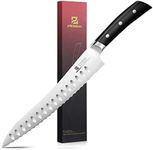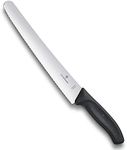Buying Guide for the Best Bread Knives
Choosing the right bread knife is essential for effortlessly slicing through different types of bread without crushing or tearing them. A good bread knife should be comfortable to use, durable, and effective at cutting through crusty exteriors and soft interiors. When selecting a bread knife, consider the type of bread you most frequently slice, as well as your personal preferences in terms of handle comfort and blade length. Understanding the key specifications of bread knives will help you make an informed decision that suits your needs.Blade LengthBlade length is the measurement of the cutting edge of the knife. It is important because it determines how easily you can slice through different sizes of bread. Bread knives typically range from 7 to 10 inches. A shorter blade (around 7-8 inches) is more maneuverable and suitable for smaller loaves or rolls, while a longer blade (9-10 inches) is better for larger loaves and provides more cutting surface. Choose a blade length based on the size of bread you most often slice.
Serration TypeSerration type refers to the pattern of the teeth on the blade. This is crucial because it affects how the knife cuts through the bread. There are two main types: scalloped and pointed serrations. Scalloped serrations are gentler and less likely to tear soft bread, making them ideal for delicate loaves. Pointed serrations are more aggressive and better for crusty, hard breads. Consider the types of bread you usually slice to determine which serration type is best for you.
Blade MaterialBlade material impacts the knife's durability, sharpness, and maintenance. Common materials include stainless steel and high-carbon steel. Stainless steel is resistant to rust and easy to maintain, making it a popular choice for everyday use. High-carbon steel is harder and can hold a sharper edge longer, but it requires more care to prevent rust. If you prefer low maintenance, go for stainless steel. If you prioritize sharpness and are willing to maintain the knife, high-carbon steel might be the better option.
Handle ComfortHandle comfort is about how the knife feels in your hand during use. It's important because a comfortable handle reduces hand fatigue and improves control while slicing. Handles can be made from various materials like wood, plastic, or composite. Wood handles offer a classic look and feel but may require more care. Plastic and composite handles are durable and often ergonomically designed for comfort. Choose a handle that feels comfortable in your hand and suits your aesthetic preferences.
Balance and WeightBalance and weight refer to how the knife feels in terms of distribution and heaviness. A well-balanced knife feels stable and easy to control, which is important for precise slicing. Heavier knives can provide more cutting power, while lighter knives are easier to maneuver. Consider your personal preference for knife weight and how it affects your slicing technique. If you prefer more control, a lighter knife might be better, whereas a heavier knife might be preferable for those who like more power in their cuts.














